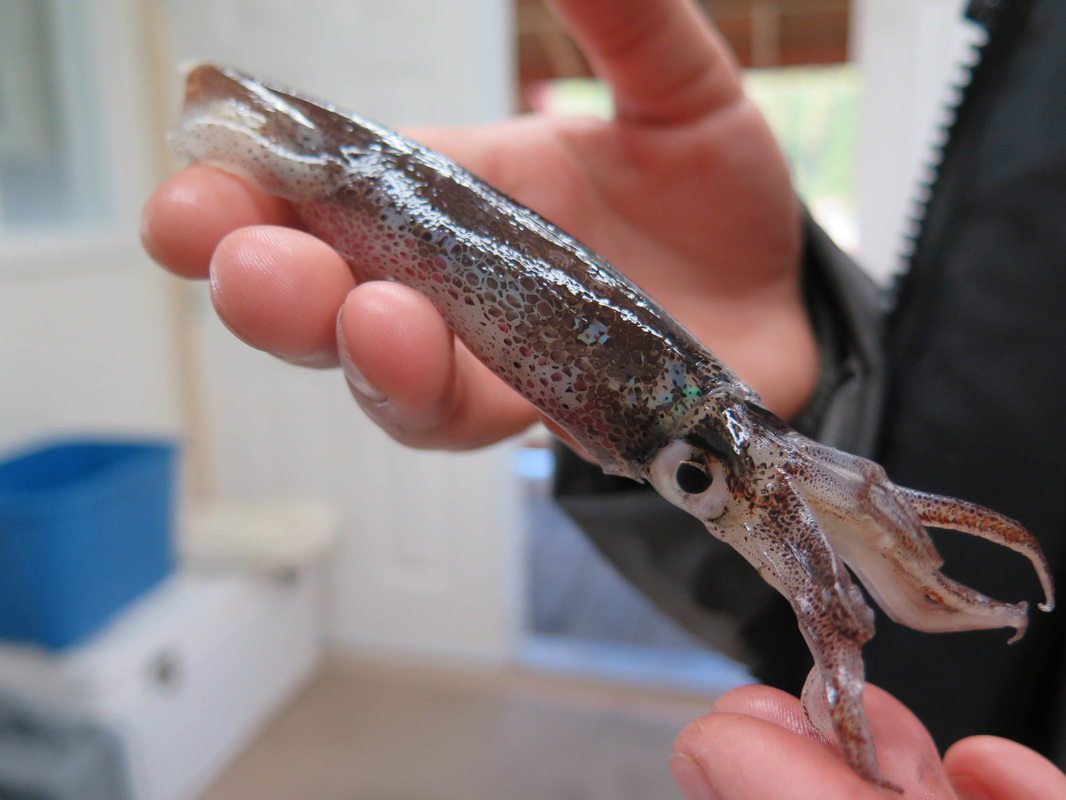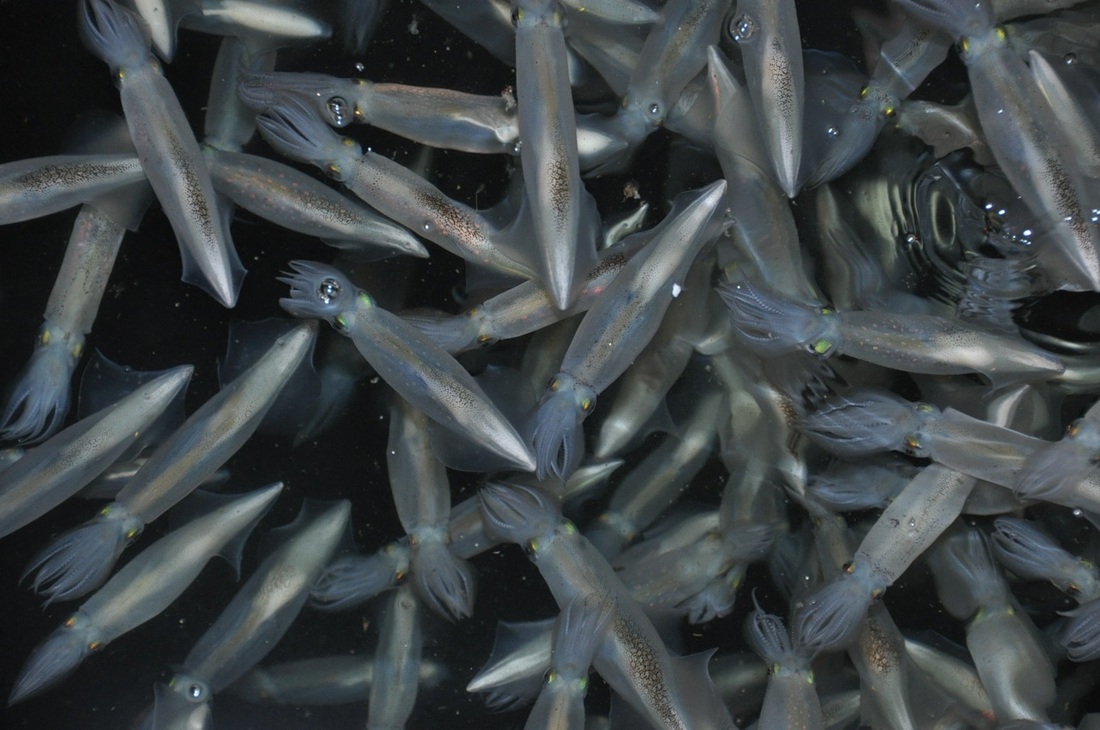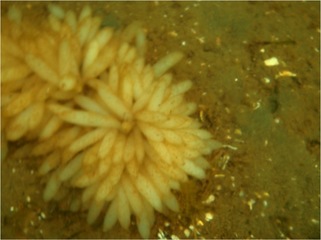Opalescent squid, market squid • Doryteuthis opalescens, Loligo opalescens • Heiltsuk/Haíɫzaqv - C̓ác̓ík̓vḷa
|
Top left: photo by Angeleen Olson. Bottom left: photo by Kaia Bryce. Top right: aggregation of spawning opalescent squid seen off the Hakai Institute dock, photo by Kira Hoffman. Bottom right: squid egg capsules. Each capsule contains 180-300 eggs. Photo by Amanda Cook.
|
Identification
The opalescent squid reaches a total length of 28 cm, with an elongated mantle composing about two-thirds of its length (to 20 cm). Its 8 long arms and 2 short tentacles make up the other third. It changes colour from translucent or iridescent white to mottled with brown and gold. It has prominent fins attached to its mantle. Eggs are laid in masses of sausage-shaped capsules.
Habitat & Range
Large schools of opalescent squid migrate through coastal waters from Mexico to southeastern Alaska. They spawn in shallow sandy bays and deposit eggs in shallow mudflats and sandy ocean floors.
Human uses
As indicated by the alternative common name 'market squid,' opalescent squid are commercially harvested - mostly in California. At one point it was the largest fishery in Monterey, California. Minor fisheries exist in BC and other locations along the west coast of North America.
Intriguing Info
Opalescent squid mate near the end of their lifespan. The mating and spawning process can be so violent that females are often injured or killed. Females can flash a white body stripe that mimics the appearance of male squid testes in order to avoid excess aggression between bouts of mating and laying eggs. Click here to read more about this trick. Each opalescent squid egg capsule contains 180-300 eggs.
iNaturalist
https://www.inaturalist.org/taxa/153981-Doryteuthis-opalescens
The following videos, filmed at the Hakai Institute, show opalescent squid hatching, swimming, and changing colour. Click here for another squid video by the Hakai Institute.
The opalescent squid reaches a total length of 28 cm, with an elongated mantle composing about two-thirds of its length (to 20 cm). Its 8 long arms and 2 short tentacles make up the other third. It changes colour from translucent or iridescent white to mottled with brown and gold. It has prominent fins attached to its mantle. Eggs are laid in masses of sausage-shaped capsules.
Habitat & Range
Large schools of opalescent squid migrate through coastal waters from Mexico to southeastern Alaska. They spawn in shallow sandy bays and deposit eggs in shallow mudflats and sandy ocean floors.
Human uses
As indicated by the alternative common name 'market squid,' opalescent squid are commercially harvested - mostly in California. At one point it was the largest fishery in Monterey, California. Minor fisheries exist in BC and other locations along the west coast of North America.
Intriguing Info
Opalescent squid mate near the end of their lifespan. The mating and spawning process can be so violent that females are often injured or killed. Females can flash a white body stripe that mimics the appearance of male squid testes in order to avoid excess aggression between bouts of mating and laying eggs. Click here to read more about this trick. Each opalescent squid egg capsule contains 180-300 eggs.
iNaturalist
https://www.inaturalist.org/taxa/153981-Doryteuthis-opalescens
The following videos, filmed at the Hakai Institute, show opalescent squid hatching, swimming, and changing colour. Click here for another squid video by the Hakai Institute.
|
|
|
References
Common market squid. Monterey Bay Aquarium. Monterey Bay Aquarium Foundation. Accessed 11/08/2014.
Harbo, R. M. (1999). Whelks to whales: Coastal marine life of the Pacific Northwest. Madeira Park, BC: Harbour Publishing. P. 122
Lamb, A., and Hanby, B. (2005). Marine Life of the Pacific Northwest [electronic version]. Madeira Park, BC: Harbour Publishing.
Lee, J. J. (2013). "Female Squid Flash Fake Testes." Weird & Wild. National Geographic. Accessed 11/08/2014.
Authors and editors of page
Kelly Fretwell and Brian Starzomski (2014).
Common market squid. Monterey Bay Aquarium. Monterey Bay Aquarium Foundation. Accessed 11/08/2014.
Harbo, R. M. (1999). Whelks to whales: Coastal marine life of the Pacific Northwest. Madeira Park, BC: Harbour Publishing. P. 122
Lamb, A., and Hanby, B. (2005). Marine Life of the Pacific Northwest [electronic version]. Madeira Park, BC: Harbour Publishing.
Lee, J. J. (2013). "Female Squid Flash Fake Testes." Weird & Wild. National Geographic. Accessed 11/08/2014.
Authors and editors of page
Kelly Fretwell and Brian Starzomski (2014).








